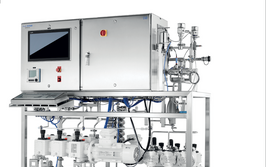
“A” Protein of Potential
Where would the biopharma industry be without Protein A? And can it ever be topped?
Protein A is a true workhorse of the pharma industry. It has been used for decades and is well established as the preferred method of purification for monoclonal antibodies because of the high yield and purity achieved in a single step (1). The technique is so common today that it is often referred to by its own acronym: “PAC” – Protein A chromatography (2), but most scientists today take Protein A for granted, without so much of a thought as to where it came from, or how much work the industry has put into refining and enhancing its abilities.
Looking back on the past techniques and technologies in one’s industry is always fascinating. Protein A is naturally occurring and natural selection has bestowed it with high selectivity. It was first discovered in 1958 when Klaus Jensen at the University of Copenhagen reported the existence of an antigen associated with staphylococci that reacted with 500 types of normal human serum. He called this antigen “Antigen A”. Four years later, two professors from the University of Umeå (Sweden), John Sjöquist and Torvald Löfkvist, demonstrated that the so-called antigen was actually a surface-wall protein on the Staphylococcus aureus bacteria. Two years thereafter, the Bergen group gave the protein its current name, Protein A. However, it was not until 1966 that Sjöquist and a doctoral fellow, Arne Forsgren, published the results of crucial experiments demonstrating that Protein A bound to the Fc part of IgG. The interaction was described as a pseudo-immune reaction and sparked a great deal of additional research on the microbiology, biochemistry and biological activity of the protein (3).
In the medical world, Protein A is the focus of much research on the virulence of S. aureus. The bacterium can cause skin and soft tissue infections, blood infections and subsequently heart infections. It is the cause of more than 20,000 deaths in the US alone each year, making it more fatal than influenza, viral hepatitis and HIV (4). Protein A plays a key role in the bacteria’s ability to evade the human immune response; the binding of protein A to the immunoglobulins reduces the effectiveness of the B cell response, thereby interfering with the development of protective immunity (5). Protein A is also one of the von Willebrand factor (vWF) binding proteins on S. aureus, promoting the adhesion of staphylococcal cells to vWF-adsorbed surfaces, such as catheters (6). Most recently, Protein A has been shown to induce bacterial aggregation, which results in biofilm formation on host tissues and implanted medical devices (7).
The road to optimization
For the purposes of antibody purification, Protein A was not even considered as a functional ligand until 1972 (8). It took six more years before a Protein A resin was commercialized and it was not until 1986 that a therapeutic antibody was approved using protein A as a capture step in the purification process (9). Early versions of protein A were produced in the native host cell, S. aureus, which is challenging to produce at large scale due to its excretion of exotoxins. However, most modern versions of Protein A are produced recombinantly in E. coli or Brevibacillus.
From an industrial standpoint, one of the most important research efforts concerning Protein A was performed by Mathias Uhlén’s laboratory at the KTH Royal Institute of Technology in Stockholm. Uhlén and colleagues demonstrated that by replacing all asparagine residues with other amino acids, one could dramatically improve the chemical stability of Protein A towards alkaline conditions (10). The discovery enabled the replacement of expensive clean-in-place reagents (for example, 6M guanidine hydrochloride) whose use previously cost as much as the initial procurement of the chromatography resin itself (11). It also simplified process development activities by reducing the VH3 interaction with antibodies, thus enabling the use of a single elution pH for a range of antibodies (12). The KTH technology was later licensed and resulted in the first Protein A resin designed for clean-in-place with sodium hydroxide.
Today and tomorrow
Today, Protein A is used in research applications and in the industrial purification of monoclonal antibodies. In the laboratory, Protein A is often used in applications such as immunoprecipitation, sample preparation and drug discovery. At the industrial scale, Protein A chromatography resins are used to purify Fc fusion proteins and monoclonal antibodies that may be used as therapies themselves or as the carrier for a cytotoxin in antibody drug conjugates (ADC). In recent years, protein A has also been used to purify antibody fragments via its natural interaction with the Fab region present on many fragments (13).
Given that Protein A resins are often identified as a relatively large contributor to cost of goods (COGs) in downstream purification, many researchers have attempted to replace the Protein A step with other technologies. Technically feasible alternatives include two phase separations, precipitation, and non-affinity chromatography.However, none of these techniques offer the simplicity, robustness and specificity that Protein A brings to antibody purification. As such, implementation at large scale is extremely limited. Ultimately, Protein A offers better process economy and faster time to market, especially when users develop processes that ensure long resin lifetime (in excess of 100 cycles).
Despite the failed attempts, I have often heard people in the industry discussing whether it will be possible to completely replace Protein A in the future. Given that Protein A has already been well optimized by natural selection and chemical engineering, however, I am not sure if a replacement will ever be necessary. Since 1978, Protein A productivity and capacity have increased 4.3 and 5.5 percent a year, respectively (14).
Best Practices
- Choose a resin with high capacity to ensure that your process can adapt to ever-rising titers in the bioreactor.
- Screen resins at conditions similar to those envisioned at large scale.
- Use high throughput process development (HTPD) techniques to develop post-load wash steps that can reduce host cell proteins (HCP), DNA and aggregates further.
- Always use bioburden reduction filters prior to your Protein A column.
- Use dedicated, low pH “strip” steps prior to clean-in-place.
- Clean-in-place every cycle, with the highest concentration of sodium hydroxide that your process and resin will tolerate.
That said, there is no need for complacency – and I expect Protein A based affinity chromatography to continue to improve in the future. I expect to see a focus on increased capacity for antibodies and overall reductions in cost of ownership. The cost of affinity chromatography has often been criticized, but, in general, Protein A resins have not become significantly more expensive from generation to generation. In addition, generational improvements in Protein A resins have led to increased productivity of downstream purification (14).
In the future, further improvements in alkali stability will also be important, driven by increased awareness of the risks of bioburden contamination on Protein A columns, which are exposed to high volumes of nutrient-rich cell culture media and subsequently cleaned-in-place with relatively low concentrations of sodium hydroxide. Additionally, there is an opportunity to further increase Protein A lifetime by enabling the use of more concentrated clean-in-place reagents to meet expectations of users (15).
I find the story of Protein A interesting from both a biological and industrial standpoint – and I hope those reading this now have a better appreciation of this everyday protein! Protein A has come a long way since the 1950s, but in reality the narrative is still relatively young. In less than 60 years, science has advanced from discovery in nature to recombinantly-produced, genetically-engineered variants of the protein that are optimized for industrial use. How much optimization will we see in the next 60 years? In an ideal world, the story of Protein A will be repeated for the next generation of therapies that are starting to populate the early clinical pipeline. Affinity solutions would be enabling for adenovirus, cell therapies, virus-like particles and more.
Jonathan Royce is BioProcess Senior Product Manager of Antibody Affinity Resins at GE Healthcare.
- A Shukla, J Thommes, “Recent advances in large-scale production of monoclonal antibodies and related proteins”, Trends Biotechnol., 28:253–261 (2010).
- X Zhao et al., “Reagent Clearance Capability of Protein A Chromatography: A Platform Strategy for Elimination of Process Reagent Clearance Testing”, BioProcess International, 13, 18-27 (2015).
- M Boyle, “Bacterial Immunoglobulin-Binding Proteins, Volume 1”, Academic Press, Inc., Referencing Press: 1990.
- RM Klevens, JR Edwards, RP Gaynes, “The impact of antimicrobial-resistant, health care-associated infections on mortality in the United States”, Clin. Infect. Dis., 47, 927-930 (2008).
- F Falugi et al., “Role of Protein A in the Evasion of Host Adaptive Immune Responses by Staphylococcus aureus. mBio”, 4, 1-9 (2013).
- J Hartleib et al., “Protein A is the von Willebrand factor binding protein on Staphylococcus aureus”, Blood, 96, 2149-2156 (200).
- N Merino et al. “Protein A-Mediated Multicellular Behavior in Staphylococcus aureus”, J. Bacteriol., 191, 832-843 (2009).
- H Hjelm, K Hjelm, J Sjöquist, “Protein a from Staphylococcus aureus. Its isolation by affinity chromatography and its use as an immunosorbent for isolation of immunoglobulins”, FEBS Lett., 28, 73–76 (1972).
- B Lain “Protein A: the life of a disruptive technology”, BioProcess Int., 11, 29–38 (2013).
- S Gülich et al., “Stability towards alkaline conditions can be engineered into a protein ligand”, J Biotechnol., 80, 169-178 (2000).
- S Jonas, M Smith, “Evaluation of an alkali stable Protein A matrix versus Protein A Sepharose Fast Flow and considerations on process scale-up to 20,000L”. Presented at the 3rd International Symposium on Downstream Processing of Genetically Engineered Antibodies and Related Molecules; 2004; Nice, France.
- S Ghose et al., “Antibody variable region interactions with Protein A: implications for the development of generic purification processes”, Biotechnol Bioeng., 92, 665-73 (2005).
- G Platteau et al., “Protein A Chromatography as Capture Step for Antibody Fragments: Mechanism of Interaction and Case Study.” Presented at PREP: International Symposium on Preparative and Process Chromatography; July 17, 2017; Philadelphia, USA.
- G Bolton, K Mehta, “The Role of More than 40 Years of Improvement in Protein A Chromatography in the Growth of the Therapeutic Antibody Industry”, Biotechnol. Prog., 32, 1193-1202 (2016).
- A Rathore et al., “Re-use of Protein A Resin: Fouling and Economics”, BioPharm International, 28, 28-33 (2015).
Jonathan Royce is BioProcess Senior Product Manager of Antibody Affinity Resins at GE Healthcare.


















